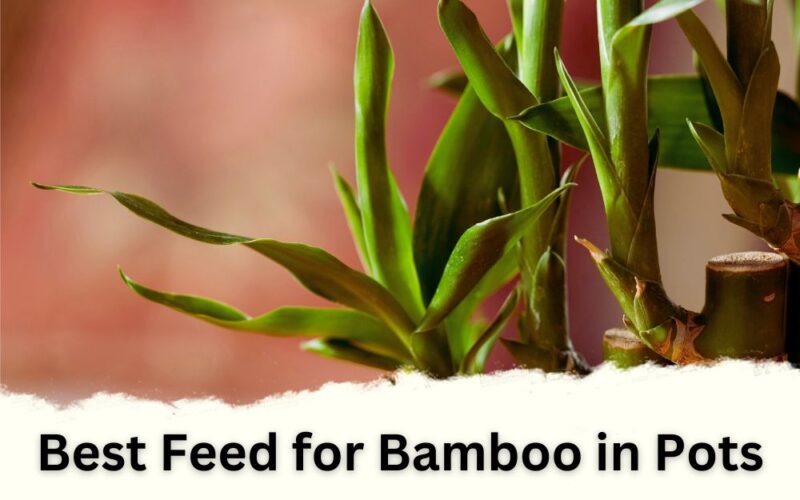Here you will find the best feed for bamboo in pots, especially lucky bamboo with pro tips for using the best bamboo fertilizer. keep reading to find out about them.
Different types of indoor bamboo plants are suitable for growing in planters indoors. Lucky bamboo is one of the most popular bamboo house plants that most indoor gardeners love to add to their indoor décor.
However, most indoor gardeners believe this plant is one of the low-maintenance indoor plants, but there are tips that you must consider to care for lucky bamboo. For example, it is important to know how to fertilize bamboo.
In my previous article, I told you what is the best fertilizer for lucky bamboo and you got familiar with various elements in a fertilizer and their work. You also found out lucky bamboo must be fertilized with a balanced fertilizer, for example, 10-10-10 and told you this plant doesn’t need to do a lot of fertilizing but you must perform it correctly.
But what kind of balanced fertilizer is the best feed for bamboo in pots? In this post, I want to tell you about Slow-release fertilizer for lucky bamboo. Here you will get familiar with this type of fertilizer and its various types and will find out the pros and cons of using it for lucky bamboo in pots. Let’s get going.
➡ You Can Hear the Audio Version of the Best Feed for Bamboo in Pots.
Best Feed for Bamboo in Pots: Slow-Release Fertilizers

First let me tell you a simple but complete definition of a slow-release fertilizer: A slow-release fertilizer is a kind of fertilizer that after adding to soil, can release nutrients to plants gradually and controlled over an extended period (for example several weeks or months). That’s great! Do you know why?
This characteristic of a slow-release fertilizer is unlike the fast-acting fertilizers (they deliver nutrients quickly to plants). The slow-release fertilizers do it due to their special coatings or materials that regulate the release of nutrients.
In most of the brands, they contain a combination of essential macronutrients (nitrogen (N), phosphorus (P), and potassium (K)) as well as secondary nutrients and micronutrients such as Fe, Mn, etc.
The nutrients are gradually released when their coating or material breaks down. Several factors play a role in the release of nutrients from slow-release fertilizers:
- Temperature of soil
- Moisture of soil
- Microbial activity in the soil
So, a slow-release fertilizer will be the best food for bamboo in pots if you provide other bamboo caring needs of your lucky bamboo such as the best temperature or best watering practice for lucky bamboo.
Various Forms of Slow-Release Fertilizers
There are several types of slow-release fertilizers available on the market. You can read some common types below. Please note that every form may be found in various formulations.
1- Coated or Encapsulated Slow-Release Fertilizers: These are granular fertilizers that are coated with a material that slowly breaks down, releasing the nutrients over time. The release rate can be controlled by the thickness of the coating.
2- Controlled-Release Fertilizers: These slow-release fertilizers contain nutrients in a form that is gradually released in response to soil temperature, moisture, or microbial activity. They typically come in the form of granules or prills.
3- Organic Slow-Release Fertilizers: These fertilizers are made from natural materials, such as composted manure, bone meal, blood meal, or fish meal. The nutrients in organic fertilizers are released slowly as the organic matter breaks down. They are ideal for those who love organic gardening and want to use environment-friendly fertilizers.
4- Polymer-Coated Fertilizers: In this type of fertilizer, the nutrients are encapsulated within a polymer coating. The coating controls the release of nutrients based on temperature and moisture levels.
5- Nutrient-Impregnated Resins: These fertilizers consist of solid resinous beads impregnated with specific nutrients. The nutrients are gradually released as the resin beads come into contact with moisture in the soil.
Please note that the different types of slow-release fertilizers offer varying release rates and durations, allowing for a more controlled and sustained nutrient supply to plants. It’s important to follow package instructions and apply them correctly for the best results.
Best Slow-Release Fertilizer Forms for Bamboo in Pots

Lucky bamboo typically grows well in well-draining soil that is rich in nutrients. Now you found out about the various types of slow-release fertilizers, let’s find which forms are best feed for bamboo in pots.
I think coated or encapsulated slow-release fertilizers would be suitable for growing lucky bamboo in soil. do you know why? The coated or encapsulated fertilizers provide a gradual release of nutrients over time, ensuring the plants receive a consistent supply of nutrients as they grow.
It is important to choose a slow-release fertilizer that is specifically formulated for indoor plants or lucky bamboo. So, you must look for a fertilizer with a balanced NPK ratio (nitrogen, phosphorus, and potassium) as this will provide your plant with the necessary macronutrients for healthy growth, so can be the best feed for bamboo in pots.
Additionally, some slow-release fertilizers for indoor plants and lucky bamboo also contain micronutrients such as iron, zinc, and magnesium, which can help prevent nutrient deficiencies and promote healthy growth.
Advantages of Slow-Release Fertilizer as best feed for bamboo in pots
Reduced Frequency of Application.
Slow-release fertilizers are best feed for bamboo in pots due to providing a steady supply of nutrients to lucky bamboo plants over an extended period, reducing the need for frequent applications. This is convenient for busy plant caretakers who may not have time for regular fertilizing.
Nutrient Efficiency of Slow-Release Fertilizers
These fertilizers release nutrients gradually, which helps minimize nutrient leaching and wastage. It allows plants to absorb nutrients more efficiently over time, promoting healthy growth and minimizing the risk of nutrient imbalances or toxicity so they can be considered the best feed for bamboo in pots.
Balanced Nutrition of Slow-Release Fertilizers
Slow-release fertilizers are often formulated with a balanced ratio of essential nutrients, including nitrogen (N), phosphorus (P), and potassium (K), along with other micronutrients. As mentioned above, this balanced nutrition as the best feed for bamboo in pots can support overall plant health and development.
Points for using Slow-Release Fertilizer as the best feed for bamboo in pots

Although slow-release fertilizers are the best feed for bamboo in pots, there are three points that you must consider before using them.
Slower Results of Slow-Release Fertilizers
if you use Slow-release fertilizers, you must be a patient gardener. they take longer to provide visible results compared to liquid or water-soluble fertilizers. Hence, If your lucky bamboo requires an immediate nutrient boost, slow-release fertilizers may not be the best choice.
Limited Control on Slow-Release Fertilizers
Once applied, it’s challenging to adjust or control the nutrient release rate of slow-release fertilizers. If your lucky bamboo requires specific nutrient adjustments due to deficiencies or changes in environmental conditions, slow-release fertilizers may not offer the flexibility to address those needs promptly.
Initial Cost of Slow-Release Fertilizers
you may think that Slow-release fertilizers are more expensive than traditional fertilizers. Yes, but please consider that due to their longer-lasting effects and reduced application frequency, Slow-release fertilizers may be cost-effective in the long run. So, if you can provide the initial cost of them, they will be economical for you.
Conclusion
In this article I showed you a Slow-release fertilizer with a balanced formulation for example 10-10-10 or 20-20-20 can be the best feed for bamboo in pots. This kind of fertilizer provides a consistent supply of nutrients to the indoor bamboo plant without the risk of over-fertilization.
Have you ever used a Slow-release fertilizer for your lucky bamboo or other indoor plants? Do you agree with me that they are the best feed for bamboo in pots? Do you use other types of fertilizer for your lucky bamboo? Please share your ideas and experiences with our readers below this page.

Elahe Rabiei
Hi, I’m Elaheh. My Academic major is plant protection, and houseplants are my expertise. As a houseplant lover, my house is full of indoor plants and it is my passion to take care of them. Hence, I’m here to share my knowledge and experience about growing healthy houseplants. I am also a plant protection advisor, so feel free to ask me any questions you may have.

